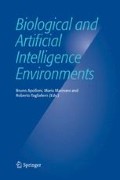Abstract
Kernel Methods are algorithms that implicitly perform a nonlinear mapping of the input data to a high dimensional Feature Space. In this paper, we present a novel Kernel Method, Kernel K-Means for clustering problems. Unlike other popular clustering algorithms that yield piecewise linear borders among data, Kernel K-Means allows to get nonlinear separation surfaces in the data. Kernel K-Means compares better with popular clustering algorithms, on a synthetic dataset and two UCI real data benchmarks.
Access this chapter
Tax calculation will be finalised at checkout
Purchases are for personal use only
Preview
Unable to display preview. Download preview PDF.
References
Ben-Hur, A., Horn, D., Siegelmann, H.T., and Vapnik, V. (2001). Support vector clustering. Journal of Machine Learning Research, 2:125–137.
Bishop, C. (1995). Neural Networks for Pattern Recognition. Cambridge University Press.
Cristianini, N. and Shawe-Taylor, J. (2000). An Introduction to Support Vector Machines. Cambridge University Press.
Dempster, A.P., Laird, N.M., and Rubin, D.B. (1977). Maximum likelihood from incomplete data via the em algorithm. Journal Royal Statistical Society, 39(1):1–38.
Fisher, R.A. (1936). The use of multiple measurements in taxonomic problems. Annals of Eugenics, 7:179–188.
Kohonen, T. (1982). Self-organized formation of topologically correct feature maps. Biological Cybernetics, 43:59–69.
Lloyd, S.P. (1982). An algorithm for vector quantizer design. IEEE Transaction on Communications, 28(1):84–95.
Martinetz, T.E. and Schulten, K.J. (1993). Neural-gas network for vector quantization and its application to time-series prediction. IEEE Transaction on Neural Networks, 4(4):558–569.
Wolberg, W.H. and Mangasarian, O.L. (1990). Multisurface method of pattern separation for medical diagnosis applied to breast citology. Proceedings of the National Academy of Sciences, USA, 87:9193–9196.
Author information
Authors and Affiliations
Editor information
Editors and Affiliations
Rights and permissions
Copyright information
© 2005 Springer
About this paper
Cite this paper
Camastra, F., Verri, A. (2005). A Novel Kernel Method for Clustering. In: Apolloni, B., Marinaro, M., Tagliaferri, R. (eds) Biological and Artificial Intelligence Environments. Springer, Dordrecht. https://doi.org/10.1007/1-4020-3432-6_29
Download citation
DOI: https://doi.org/10.1007/1-4020-3432-6_29
Publisher Name: Springer, Dordrecht
Print ISBN: 978-1-4020-3431-2
Online ISBN: 978-1-4020-3432-9
eBook Packages: Computer ScienceComputer Science (R0)

